Featured
Does Kashmir have the chutzpah to dream again?
Praveen Patil
Nov 11, 2014, 02:46 PM | Updated Feb 10, 2016, 04:59 PM IST
Save & read from anywhere!
Bookmark stories for easy access on any device or the Swarajya app.


After 25 years of bloodshed, Kashmir is ready to turn a new leaf and that Marxian idiom of an interplay between farce and tragedy is on the verge of being challenged by Karma
( 5Forty3 and Swarajya will be doing a special series analysing the Jammu, Kashmir and Ladakh elections. This is the first part of the series – a curtain raiser on an election that promises to be a riveting fight to the finish. This is a slightly condensed version. Read the complete post here )
These are probably the first elections in the midst of hope in the valley, a hope that is as yet a flickering candlelight and not a blooming sunrise, but hope nonetheless. This newfound hope is preceded by the worst deluge that the state faced in many decades in the midst of a stellar role played by the Indian army much to the chagrin of Islamic ideologues and separatists. This newfound hope is also an acknowledgement of a new no-nonsense India which can potentially walk that extra mile provided Kashmir too embraces the politics of development and shuns violence.
It is in this atmosphere of hope that a Narendra Modi led BJP has announced its seemingly impossible ‘mission 44+’ with much fanfare and some sound strategic thinking. At the very outset, this move by BJP has put the separatist forces in a limbo. To be sure, there is still a boycott call by secessionists, but its actual implementation is a dicey act, for the turnout in the valley is now a double edged sword hanging on the proponents of Azaadi. If the turnout is low, then there is a very real possibility of BJP being a force to reckon with in about half-a-dozen seats even before the high pitched campaign by Indian PM is unleashed. On the other hand, if the turnout in the valley is high, the very raison d’être of the Kashmiri separatists would be under mortal threat. In both the scenarios India stands to be the gainer.
This is a classic case of a nationalist, right-wing government placed in Dilli dealing with Kashmir from a position of strength without any extraneous considerations of a pan-India vote-bank under duress or a burden of vacuous intellectualism. This is in continuum of a Vajpayee world-view, only more forceful and a lot less circumspect. No matter how dovish a picture that the Delhi based editorial class wants to paint of the Vajpayee government vis-à-vis Kashmir, the fact is that India under Vajpayee first systematically destroyed the terror apparatus in the valley and only then pushed for peace talks (as borne by the chart on casualties below). Today, Modi and BJP have a chance to reach out to Kashmir with even more clarity and on a lot more surer footing.
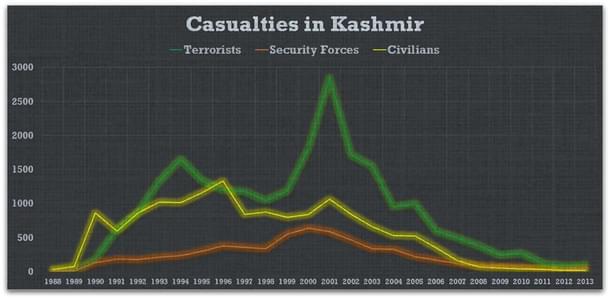
Yet, what Modi and BJP are attempting in Kashmir is far more audacious than what any government in Delhi has ever tried. If many political commentators are terming ‘mission 44+’ as nothing but a pipedream, they do have a point no doubt. Past electoral data makes it almost impossible for BJP to win beyond 25 odd seats in the Jammu and Kashmir assembly. In fact, in the summer LS polls, when BJP got a whopping 32.4% vote-share in the state for the first time, the party managed to lead only in a maximum of 25 assembly segments, despite winning 3 out of 6 Lok Sabha seats.
What is more, National Conference and Congress combine had a 2 percentage point lead over BJP and yet drew a blank, while PDP, with merely 20% vote-share managed to take pole position in 41 assembly segments of the state. If the LS poll results are replicated in the upcoming assembly elections, then one can rest assured that PDP is heading for a near clear majority in the state, what with a regional party being an even bigger beneficiary of anti-incumbency vote in state polls than in national elections.
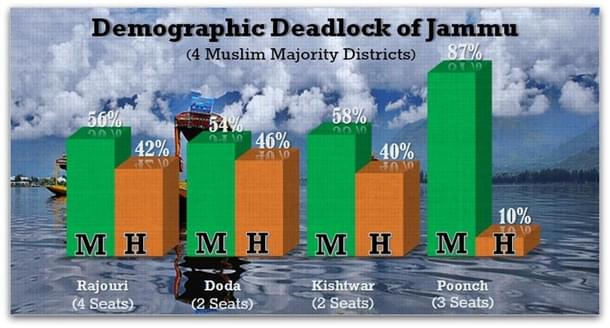
Of the 25 assembly segments that BJP led in the Lok Sabha elections this year, 24 are located in the Jammu region where the party secured 48% vote-share. Of the remaining 13 seats in Jammu, BJP finished second in 6, mostly from Rajouri district and parts of Chenab valley spread across the two Muslim majority districts of Doda, and Kishtwar. Thus at the outset, we can cap BJP’s best case scenario at 30 out of 37 in Jammu region, which is further reduced to a realistic level of 26-27assembly seats at the most. Even if one adds 3 seats in Laddakh to BJP’s kitty (where the party only led in 1 segment in May), the party’s tally remains under 30. Thus it is clear that BJP and Modi need to break the demographic deadlock in order to go beyond the ordinary even in Jammu region.
The very backward Chenab valley goes to polls at the start of electioneering on the 25th of this month and it would set the tone for the elections in the state. In the 2008 assembly polls, Congress and NC had literally swept this region by winning all the 6 seats, while Congress on its own had managed to win 5 seats. Even in the LS polls, while Chenab strongman, Ghulam Nabi Azaad had lost the Udhampur LS seat to BJP’s Jitendra Singh, he had still managed to take leads here. Thus, for BJP to emerge beyond 30+ seats in Jammu and Laddakh region, Rajouri and Chenab will be crucial first tests. There is of course hope in the air:
- With Mehbooba Mufti running a high pitched campaign in Chenab valley and Congress & NC facing very strong anti-incumbency, there could be a division among Muslim voters (especially Kashmiri Muslims) – which can make a difference in 8 seats
- BJP’s systematic micro-targeting of Gujjar, Bakherwal and Dogra Muslims by allotting tickets to these subgroups may yield some dividends in this backward region because these communities vote along tribal-clannish lines and are seldom swayed by separatist ideologies
- A Modi campaign has the ability to convert this into an election for development which may strike a chord with Chenab valley cutting across religious lines due to scant development beyond Jammu district, a sub-regional anomaly that has often gone unnoticed by the ruling elite
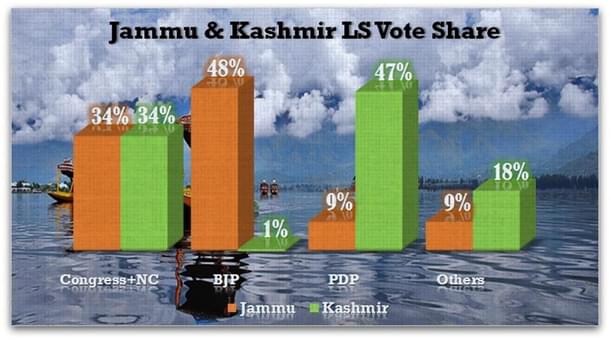
Even with 30 odd seats in its kitty from Jammu and Laddakh, BJP would be hard pressed to win any seats in the Kashmir valley. Eventually, let us face it, this is an election for Kashmir. Without winning Kashmiri hearts, to whatever extent possible, nobody can rule this frozen teardrop on the Himalayas. Congress and NC have a symbiotic vote bank in the state with a neat division as was evident in the Lok Sabha elections. At the outset, BJP and PDP, with their skewed vote-share, would have been natural allies, but neither the politics of the state is so straightforward nor the new Modi led BJP thinks along such lazy lines – as was clearly evident in Maharashtra and Haryana just last month when the party dumped natural allies and an easy path, to win hard fought victories on its own.
Evidence from the ground suggests that BJP’s strategy in Kashmir valley is essentially twofold; the first part of that strategy is arithmetic in nature with liberal doses of support from KPs. There are roughly 1 lakh registered Kashmiri Pandit voters in the valley who are mostly refugees in Jammu. A vast majority of these KP votes are concentrated in Srinagar and Anantnag districts (almost 60%) and their presence is significant in 6 assembly segments. BJP is betting on a low voter turnout in these assembly seats and a division among Muslim votes along the lines of PDP v/s NC v/s ‘Others’ and a one-way consolidation of KP votes in favour of the party candidates.
Even if 50% of KPs turnout to vote in special polling booths that the EC has set-up in Jammu, Udhampur and Delhi, BJP’s strategy may actually yield results. The problem is, for all the talk of Kashmiri Pandits wanting to return back to their homes, very few of them actually turnout to vote in elections. For instance, in the LS polls this summer a paltry 12438 Kashmiri Pandits exercised their franchise – a humiliating sub 15% turnout!
Realising the gravity of the situation, BJP and RSS cadre are working overtime to assemble and enthuse Kashmiri Pandits to turn up in respectable numbers this winter. It remains to be seen how far the saffron party succeeds in its efforts to at least bring out 50% of KP voters. Along with the dependence on KP voters, BJP is also giving tickets to a large number of Muslims – 17 out of the 49 names announced so far – and some of these Muslim candidates are turning out to be extremely competent campaigners and are giving sleepless nights to entrenched players in the valley like PDP and NC. Dr Hina Bhatt is obviously the most visible face of the party in and around Srinagar; she is supposed to have a very good chance of emerging victorious with the support of KPs and a section of Muslims in downtown Amira Kadal assembly segment.
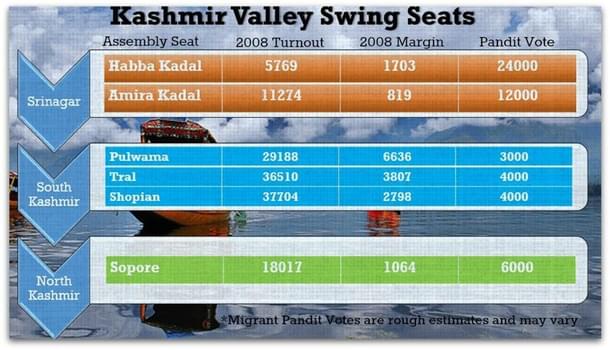
The second part of the BJP strategy is more amorphous and is actually a continuation of its very successful foray in UP and Bihar during Lok Sabha elections last summer and in Maharashtra and Haryana assembly elections more recently. In UP, Bihar and in Maharashtra, BJP built small sub-regional, district level social coalitions to augment its broader national appeal which yielded cumulative results in elections. Now taking this forward, the saffron party is working overtime to help build small sub-regional parties in the Kashmir valley where the polity was essentially bipolar till now.
Even in the summer LS polls, a host of smaller parties and independents secured a reasonable 18% vote-share in the valley, pointing towards a far more fragmented vote in Kashmir than many political pundits believed (despite many smaller regional parties not taking part). Conventionally, in assembly elections, the vote-share graph of “others” rises incrementally as compared to national elections. In this assembly elections, there would be at least 6-9 smaller sub-regional parties like Sajjad Gani Lone’s ‘Peoples Conference’, Ghulam Hassan Mir’s ‘Democratic Nationalist Party’, Farukh Renzu Shah’s ‘Kashmir Development Front’ etc. which have the potential to offer a third pole to the voters.
Together, if the “Others” vote-share doubles from 18% to 36% in the assembly elections, then BJP can gain in two ways. On the one hand, other parties would divide the traditional vote-banks of PDP and NC, thereby helping BJP establish a toehold in the valley and maybe even win a couple of close contests. On the other hand, if the smaller parties win a handful of seats, they can always have a post-poll coalition with BJP, thereby starting a new chapter in the politics of Kashmir.
If BJP and “Others” manage to get around 40% vote-share in the valley, PDP and NC would be left with merely 60% of votes to try and win a majority. Such a scenario would make it extremely difficult for PDP to repeat its LS performance of a 41 assembly segment lead. On the other hand, Omar Abdullah is facing an almost complete rout. Thus, it can be stated with reasonable clarity that BJP’s ‘Mission 44+’ is not as much a pipedream as it appears at the outset. Yet, this also has a potential to produce a Tamil Nadu or Odisha like outcome, wherein a strong BJP showing could result in a clear victory for a local party like PDP.
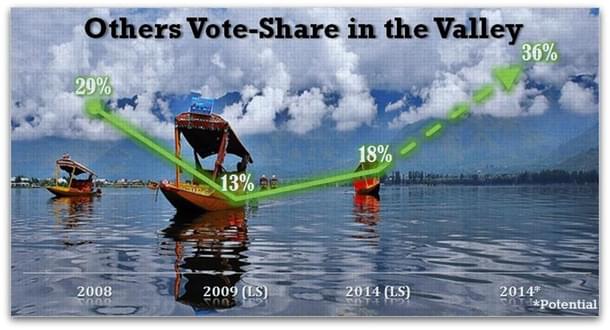
There could be a third part to BJP’s strategy, not strategy in fact, but a more powerful outreach to the people of Kashmir. This is Modi’s moment in history, can he really weave his magic of hope in the final frontier of Indian political landscape? Can he liberate this problem child born out of a civilizational conflict from a spectre of fundamentalism and militancy into the lap of mundane economic realities of everyday life by bringing to the forefront the issues of bijlee, sadak, paani and naukri? More importantly, will Modi rise up to the occasion and offer a hand of friendship to his Muslim Kashmiri brethren unconditionally?
Literature often reminds us that a woman’s tears are capable of giving birth to a revolution. If ever there was a test for such a romantic notion, none would be greater than today’s Kashmir. The most ravaged of the Kashmiri lot are the women who have lost everything and are the first to embrace hope. In small but steady measure, women are looking at the PM with hope, especially after the recent floods. Modi, who has always held a certain attraction for the women voters, would be keenly watched during his public rallies and speeches. How would Modi heal the wounds of Kashmir and wipe the tears of Kashmiri women is a subplot worth monitoring in the run up to the elections.
To be sure, BJP is informally reaching out to even what is termed as ‘moderate separatist’ leadership like Sajjad Lone and is potentially creating a bridge to the valley, a bridge that has often meandered in the past. Mercifully, Modi is not Nehru, either in deed or in thought, so one can be reasonably assured that national interest will guide him in his approach rather than any “ideas of India”. Even more fortunately, Modi is no Rajiv Gandhi, so he is not expected to make those childish mistakes of Nehru’s grandson. For instance, if BJP fails to get anywhere close to a majority, then it would always be wise to support a PDP government unconditionally rather than play with fire like Rajiv in the 80s. The only worry is that this historic moment has come too early in Modi’s prime ministership and one is not sure how well is he prepared for it, but then Modi has been an invention of Karma who has the capacity to bargain for an opportunity with history.
Analyst of Indian electoral politics and associated economics with a right-of-centre perspective.





